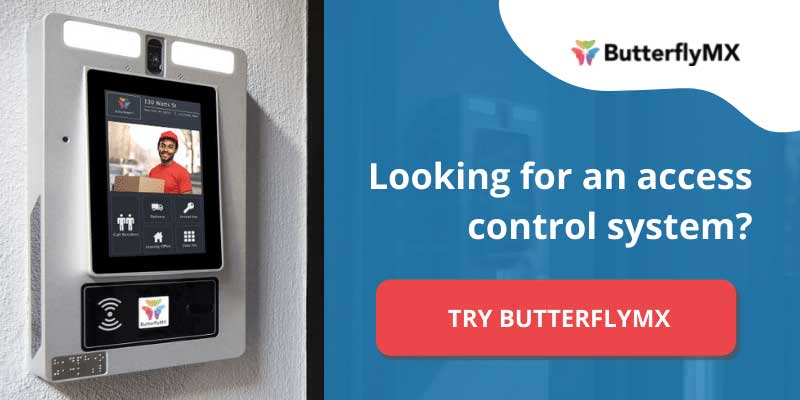Key takeaways
- Access control design is a way you can think about access hardware and practices to make sure your property is secure.
- When designing an access control system for your own property, make sure to keep resident security and convenience, delivery couriers, and credentials in mind.
- The most popular access models you can choose between are role-based, attribute-based, discretionary, and mandatory access control.

When you’re in charge of determining the appropriate access control model for your building, you have a lot of factors to keep in mind. To help you provide the best experience for your residents, you can learn about access control design and make sure you’re balancing security, convenience, and your residents’ needs.
In this post, we explain what access control design is and how it can affect your property. Then, we go over the most popular access control designs and help you design an access control system that’s right for your building.
This post covers:
- How to design an access control system
- 4 types of access control designs
- What is access control design?
How to design an access control system
If you’re interested in installing an access control system on your property, here are some best practices for access control that you should keep in mind.
Here’s how to design an access control system:
Weigh security and convenience
While security is always a priority, you also have to balance security with convenience. Even a high-security property might lose tenants if those tenants get fed up with lengthy and inconvenient access control procedures.
So, you need to think about the type of tenant you want to attract and scale your security system design to match. While some high-stakes security procedures might befit tenants like hospitals or top-security industrial facilities, those same protocols and access measures might turn tenants away if your property offers security that isn’t proportional to their needs.
Consider deliveries
Now that online deliveries are a fact of modern life, every building must be set up to receive and store packages. The right access control design can be the difference between a tenant seamlessly getting their package and a missed delivery.
How far should you let a delivery courier onto your property? Will they have to enter gates and locked doors — and what credentials should they use to do it?
The best delivery solution is electronic. If you install a system that allows residents to send virtual delivery passes to their couriers, you sidestep all of these access issues entirely — and you free your staff to focus on other tasks, too.
Choose credentials
A well-designed access control system reduces the number of credentials that a resident has to carry around — and it might even allow them to go completely credential-free.
If your access system is all analog, you force residents to carry a key for every space they need access to. And when you’re talking about the front door, their unit door, a garage, and amenity spaces like gyms, all those keys add up.
In contrast, with an electronic system, you can hand residents a single swipe card for door entry that they can use for every space — wherever they are on the property. You might even design an access control system that pairs with a mobile app so residents can use their phones to open doors.
Learn more about access control:
4 types of access control designs
No matter what kind of hardware you choose to secure your property, you’ll always need an organizational framework to make physical access control easy. Your building residents may need access to new spaces. Or, you might need to add new residents and revoke access entirely as residents move in and out.
Depending on the needs of your property and tenants, you can choose between four different access control models. So, what are the four types of access control?
Four types of access control designs are:
- Mandatory access control
- Discretionary access control
- Role-based access control
- Attribute-based access control
1. Mandatory access control
Mandatory access control is a system that empowers one administrator to add, remove, and edit resident access permissions.
If your property is smaller and only has a few tenants, mandatory access control is right for you.
2. Discretionary access control
In contrast to mandatory access control, a discretionary access control plan allows multiple administrators to make changes to the system.
For a property with multiple commercial tenants, discretionary access control allows each business to manage access for its own employees.
3. Role-based access control (RBAC)
Role-based access control determines access for tenants depending on what you categorize them as. For example, you might manually create a “staff” role with access to storage closets, or an “IT worker” role with special access to server rooms.
An RBAC system design is best for residential properties or other properties where tenants are set in their roles. In a residential building, it’ll be rare for a tenant to switch over to being staff or vice versa, which cuts down on the number of manual changes you’ll have to make.
4. Attribute-based access control (ABAC)
Attribute-based access control keeps track of people’s attributes and changes their access permissions in real-time, without requiring an administrator to step in. For example, if an ABAC system detects that a worker got a promotion, it will automatically grant that worker access to higher-security areas.
To set up attribute-based access, make sure to choose sophisticated technology like an RFID or IP door access control system. While ABAC has real-time updating features, it is more expensive. It’s right for bigger properties with large commercial tenants.
What is access control design?
Access control design is a way of choosing access control hardware and software to build an effective access control system that anticipates and suits your building’s security needs.
Controlling access into and throughout your property requires more than just purchasing an intercom or a keypad and hoping for the best. You have a lot of questions to ask yourself first.
For example, which entryways and access points need to be secured? And what kind of credentials do you want your residents to use?
Access control design and installation are just parts of the puzzle. When all of your hardware is up and running, you’ll also need to keep adjusting the system as residents move in, move out, and need updates to their access permissions.
There are several different frameworks called access control models that you can use to simplify the process of assigning and editing people’s security credentials based on your access system’s needs.







